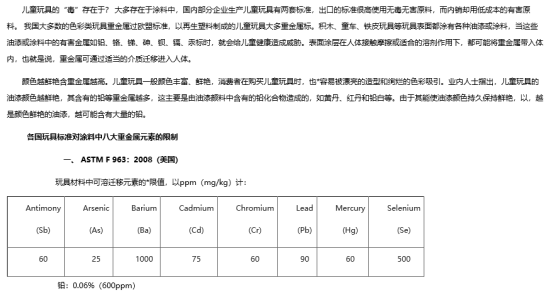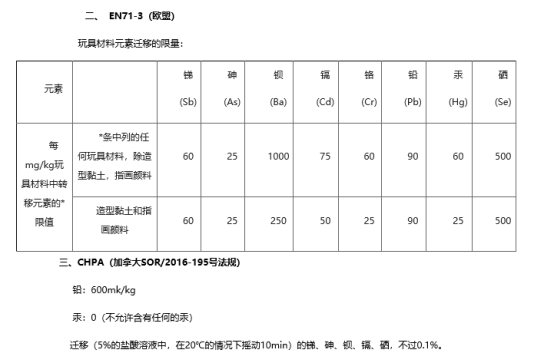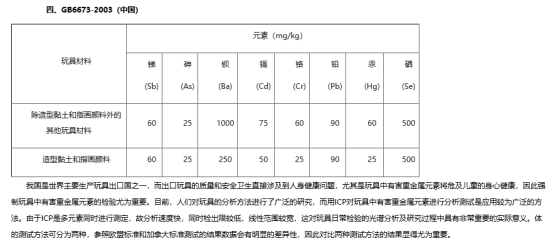service items
CPC certification for babies and toys
CHPA Canadian toy export standards are Canada's normative standards for toys, stationery, small crafts and other products. Canadian toy CCPSA (formerly known as CHPA) certification introduction: For the toy industry in Canada, the relevant laws are mainly the "Hazardous Products Act" (HPA) and its implementing regulations "Hazardous Products (Toys) Regulations". Formerly known as the Product Safety Bureau) management and execution. In addition, Canada passed the Canadian Consumer Product Safety Act (CCPSA) on December 15, 2010, which will be implemented in June 2011 and will replace Part I and Appendix I of the Dangerous Products Act.
The main items tested are:
1. Testing of physical and mechanical properties
2. Physical combustion test
3. Testing of toxic heavy metals.
The Canadian Dangerous Products (Toys) Regulations (CRC, C.931) mainly include: CHPA label requirements, electrical hazards, suffocation hazards, toxicity hazards, fever hazards, mechanical hazards, special products (including dolls, plush toys and soft toys) Toys, push-pull toys, watercolor paint applied with fingers, rattles, elastic cords, batteries and cosmetic toys).
The toxicity test in the Canadian CHPA standard mainly involves the limit of the migrating amount of the 7 major elements (lead, antimony, arsenic, barium, cadmium or selenium). The requirement is not to contain; antimony, arsenic, barium, cadmium and selenium are tested for soluble content, and the limit is 0.1%, and the lead test is for the total amount, and the limit is 600ppm.
Control of heavy metals: Pay special attention to substances that easily exceed the standard. Such as paint, ink and polymer coating; solid or liquid finger paint, lacquer, glaze powder and other materials. Such as synthetic leather, plastic cloth and metal materials may also exceed the standard, we should also pay attention to, hard plastic materials, ceramics and glass are generally not easy to exceed the standard.
Canadian toy CCPSA (formerly known as CHPA) certification added two new test items in November 2011, one is lead content test, and the other is phthalic acid content test. The Canadian government has also continuously improved the certification requirements. The difficulty of certification also increases.
On November 25, 2016, Canada issued SOR2016-302[1] to amend the toy regulations (SOR2011-17)
This revision mainly updates part of the content and changes the management rules, but does not make major changes to the manufacturer's responsibilities.
The revised content includes:
Add "good scientific practice" and "empirical data". The above new definitions are listed in Plan 2 and Plan 3.
Part of Chapter 7 "Small Parts" has been changed. The relevant requirements remain unchanged.
The content of Chapter 26 and Chapter 27 is simplified and the presentation is clearer. Delete the phthalate regulations (SOR/2016-188); but the phthalate regulations are still binding on toys. Remove food-grade plastic requirements.
Completely delete the toy battery requirements in Chapter 43 and Plan 9. Delete the requirements for battery structure related to toy batteries.
The contents of product toxicity in Plan 2 and Plan 3 were revised.
In Canada, all toys used by children 12 years of age and under must meet the federal safety standards set by the Canadian Consumer Products Act (CCPSA), including:
Canadian Toy Regulations (SQR/2011-17)
Lead-Containing Consumer Products Regulations (SOR/2018-17)
Phthalates Regulations (SOR/2016-188)
Surface coating material regulations (SOR/2016-193)
Canada Amazon Children's Toy CCPSA certification process:
1. Provide a sample map;
2. Confirm testing standards and regulations;
3. Provide physical sample testing;
4. Pay the inspection fee;
5. Test samples and issue a test report if the test is qualified;
6. If the test fails, resubmit the sample for test.
Canada Amazon children's toys CCPSA certification fee:
Depending on the product, different product inspection fees are different, and product pictures can be provided to estimate the cost.



加拿大已基于消费品安全法案(CCPSA)颁布了一系列法规来管控多种消费品的安全。其中多项法规已于2016年6月生效。
2011年1月,我们就CCPSA成为法律一事进行了通知。CCPSA于2011年6月生效,其目的是解决或预防消费品对人类健康产生的危害。该法律适用于加拿大消费品的制造商、进口商、分销商、广告商和零售商。
CCPSA由加拿大卫生部执行。消费品必须遵循CCPSA下的相关法规要求。CCPSA下所管理的消费品包括但不限于:蜡烛、童车和婴儿小推车、珠宝、睡衣、涂釉陶瓷、婴儿喂养奶瓶、水壶、安抚奶嘴、邻苯、游戏围栏、机动车辆约束系统和和儿童座椅、科学教育套件、表面涂层材料。
2016年7月13日,加拿大在加拿大公报第二部分发布了CCPSA下的修订法规。根据法规影响分析陈述,发布修订法规的目的是在2011年监管修订的基础上对CCPSA下的32项法规进行非实质性变更。各种条例的适用范围被修订以符合加拿大消费品安全法的立法语言。这些修订并没有对消费品的管控要求做出显著的变化,并且不会影响现有的遵守和执行机制。这些修订包括:
-废除和取代29项条例(表1)。一些新条例被重命名,如“婴儿喂养奶嘴条例”、“床垫条例”和“奶嘴条例”。
- Amending 3 Regulations:
-修订了3项条例:
-消费化学品和集装箱条例(SOR/2001-269)被修订为SOR/2016-170;
-含铅消费品(接触嘴)条例(SOR/2010-273)被修订为SOR/2016-171;
-玩具条例(SOR/2011-17)被修订为SOR/2016-195。
这29项“新”条例和3项新修订条例已于2016年6月22日生效。
表1总结了“新条例”和相应“被废除条例”的对比
在上述32项条例发布之前,加拿大公报第二部分发布了以下条例。
-新香烟引燃倾向(消费品)条例(SOR / 2016-103)于2016年5月20日发布并将于2016年11月17日生效。
-新婴儿床,小床和摇篮条例(SOR / 2016-152)于2016年6月29日发布并将于2016年12月29日起生效。关于新法规的详细概述可在SGS Safeguards 137/16上查看。一旦新的条例生效,现有的婴儿床,小床和摇篮条例(SOR / 2010-261)将被废除。
CCPSA下的以下条例保持不变:
-行政罚款(消费品)条例(SOR/2013-101)
-豁免条例(消费品)(SOR-2015-97)






 telephone:
telephone: Phone:
Phone: Email:
Email: Address:
Address: